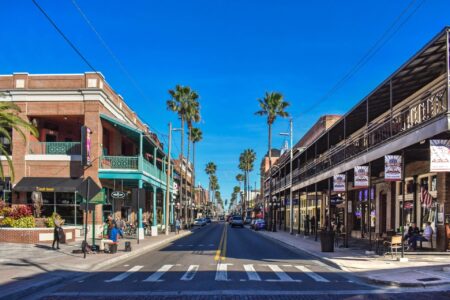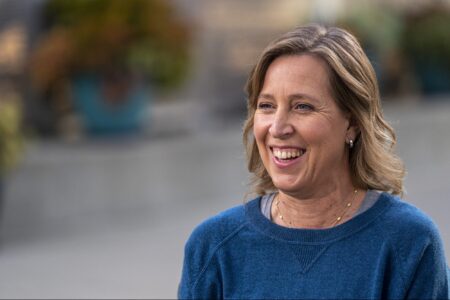There is a very short list of player-owners in professional sports. Mario Lemieux became a part-owner of the Pittsburgh Penguins during his time on the ice. Michael Jordan came out of retirement when he became a minority owner of the Washington Wizards. And now two-time world champion sailor Mike Buckley is the co-owner, CEO and Strategist of SailGP’s U.S. team.
SailGP is a global racing league created by Oracle founder Larry Ellison and America’s Cup sailor Russell Coutts that features 10 national teams battling in high-tech, high-speed 50-foot foiling catamarans. Over the course of the season, races take place at locations around the world — New York, Dubai, and Sydney, to name a few — with the three highest-ranked teams competing in the Grand Final.
Related: ‘Formula 1 on Water’: How SailGP Is Making Big Waves in the Racing World
As the new season gets ready to set sail on November 23, I caught up with Buckley to learn his philosophy for risk-taking on and off the water, and how he and his partners went about securing investment from a diverse group that includes actress and producer Issa Rae, NFL stars DeAndre Hopkins and serial entrepreneur Gary Vaynerchuk.
You don’t have a very “normal” job. Can you explain how someone becomes a boat racing strategist?
I grew up with a single mom who worked a lot of jobs. I never met my dad. So sports were like sort of free babysitting for my mom and they kept me out of trouble. I always played hockey and football and lacrosse, but when I went to boarding school in high school, I realized I was not going to play these sports there. I was a boy among men! So I tried out for the sailing team — my mother had a deep love of the ocean and passed that to me. A lot of the other kids treated it like it was a fun hobby, but I’ve always loved competing so this became my new arena. And that got me into college and then into this career. It’s not a normal career, but I’ve never really subscribed to normal.
What does it take to be a great leader on the water?
I think it’s the same with anything. What makes Steve Jobs great? Or Kobe Bryant? I think it’s the relentless pursuit of perfection and knowing that perfection actually doesn’t exist. But you’re just constantly willing to continue to fight. Even if you’ve fallen on your face a few times, you’ve got that drive to achieve your dreams.
There are legendary stories about Kobe Bryant going to the gym at 3 am and shooting the same shot over and over. How does that translate to the world of sailing?
For a long time, I never really understood when you’d hear point guards or quarterbacks talk about the game slowing down for them. But now I get that is very translatable to the world of racing sailboats, especially in SailGP, where our boats are going 50 or 60 miles an hour. If the game is fast, that typically means your heart rate is up and you’re not communicating well and it spirals down from there. But when you’ve practiced, when you’ve seen it over and over again, then you kind of know what’s about to happen and you can calmly assess the situation and make the correct call. The game slows down for you.
What inspired the transition from being a racer to a co-owner of the team?
I’ve always got a lot of my motivation from other athletes, and you listen to guys like LeBron talk about building up their businesses and it made me think, “How could I do that in the sport of sailing?” In this sailing world, you rub shoulders with so many successful people — epic entrepreneurs who have done all of these amazing things. Taylor Canfield, one of my longtime partners on and off the water, and I tried to put two different America’s Cup campaigns together and we kind of fell flat on our faces. But when SailGP came along, we saw it as the perfect platform for us not only to compete but also build a commercial business that has real value, that’s investable, that’s sustainable.
Credit: Ricardo Pinto
You’ve got a pretty diverse group of investors — NFL stars, Hollywood stars, and entrepreneurs like Gary Vaynerchuk. How did you go about bringing them in?
Ryan McKillen, who is a co-owner of the team and was the third employee at Uber, is just one of the most brilliant people I’ve ever met in my life. When we went out to bring on investors, we came up with three rules: One was we only wanted to do business with really good people — we wanted this to be fun. Second, we wanted people who were just doing epic things in their spaces. It didn’t matter if that was behind a desk or in a DJ booth or on the NFL field — we just wanted people who are innovators. And finally, we said no sailors. If we want to change our sport and commercialize it and bring it to the masses, bringing a bunch of people who all think alike is a great way to have a really average product.
Related: How This College Dropout Raised $29 Million for His Online Education Platform and Landed the Biggest Investor of All — Shaq
Can you describe what it is like being on one of these boats?
When I say we go 60 miles per hour, it sort of sounds cool and fast, but not like an F1 car that’s going 180. But I like to say that going to 60 miles an hour over the water is very similar to when you’re driving down the highway — except that you are sitting on top of the roof and it is raining the entire time. That’s basically what it’s like.
Does being an owner make you more or less risk-averse when you’re competing?
When we step foot on the boat, we know the risks. And we very much bury them at the very back of our brains. If you’re thinking about the risks while you’re actually doing it, you probably shouldn’t be out there. But look, I’ve got two little kids now so I don’t want to do something silly out there. But in terms of being an owner versus being an athlete, it is really the same thought process.
Do you have any rivalries?
We’re just getting started, so our rivalry is with ourselves improving. Sure, some of us get along better or worse with certain people on other teams, but there’s a huge level of respect across the board. In this league, in terms of safety, you’ve got to trust the people on the other boats. But my drive is focused inward — what we’re going to improve so that we can go out and make ourselves and our families and our fans and our partners proud as we compete.
Related: NFL Great Stefon Diggs Has a Plan to Change the Game in Fashion
Read the full article here












